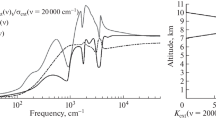Summary
A method is presented for the calculation of solar heating rates in turbid and cloudy atmospheres. In contrast to other typical two-stream procedures, the system of differential equations describing the radiative transfer is decoupled through the application of a series expansion of the flux densities resulting in a single analytical expression for each flux. The present method (PM) yields a solution for the entire atmosphere instead of individual atmospheric layers. This procedure avoids as part of the solution scheme the inversion of a rather complex matrix thus resulting in high numerical efficiency. The model includes the absorption by atmospheric gases such as water vapor, CO2, O3 and NO2. This list can be extended if desired. Moreover absorption by aerosols and cloud particles is accounted for in addition to multiple scattering. A comparison with the rather accurate and already efficient transfer code of Zdunkowski et al. [6] shows that the present method is similarly accurate but numerically even more efficient. Therefore, this radiation scheme becomes very suitable for use in some circulation models of the atmosphere, such as prediction models of radiation fog.[/p]
Zusammenfassung
Das hier vorgestellte Verfahren dient zur Berechnung solarer Erwärmungsraten in trüben und bewölkten Atmosphären. Im Gegensatz zu sonst üblichen Zweistrommethoden wird das hier auftretende gekoppelte Differentialgleichungssystem für die nach oben und unten gerichteten Strahlungsflußdichten mit Hilfe eines Reihenansatzes entkoppelt. Dadurch wird die numerisch aufwendige Invertierung einer Matrix umgangen und somit die Rechenzeit erheblich reduziert. Das Modell erfaßt die Absorption atmosphärischer Gase wie Wasserdampf, CO2, O3 und NO2. Diese Liste kann - wenn gewünscht - erweitert werden. Weiterhin wird die Absorption von Aerosolen und Wolkenteilchen zusätzlich zur Vielfachstreuung erfaßt. Ein Vergleich mit dem von Zdunkowski et al. [6] angegebenen Zweistromverfahren zeigt, daß dessen Genauigkeit fast erreicht, aber die numerische Effektivität noch erheblich übertroffen wird. Deshalb eignet sich das gegenwärtige Berechnungsverfahren solarer Erwärmungsraten z.B. zum Einbau in Vorhersagemodelle von Strahlungsnebeln.[/p]
Similar content being viewed by others
Abbreviations
- AS :
-
surface albedo for diffuse solar radiation
- A s(μ0):
-
surface albedo for parallel solar radiation
- β0 :
-
backward scattering coefficient of diffuse radiation
- β(μ0):
-
backward scattering coefficient of primary scattered solar radiation
- f :
-
fraction of radiation contained in the diffraction peak of the phase function
- F l,F 2 :
-
diffuse upward and downward flux densities
- F net :
-
net flux density
- μ0 :
-
cosine of solar zenith angle
- p 1/3:
-
asymmetry factor of the phase function
- S :
-
parallel solar flux density with respect to a horizontal surface
- S 0 :
-
solar constant
- τ :
-
optical thickness
- ω:
-
single scattering albedo
References
Dirmhirn, I.: Das Strahlungsfeld im Lebensraum. Frankfurt: Akad. Verlagsgesellschaft 1964.
Geleyn, J. F., Hollingsworth, A.: An Economical Analytical Method for the Computation of the Interaction Between Scattering and Line Absorption of Radiation. Beitr. Phys. Atmosph.52, 1–6 (1979).
Hall, W. D.: A Detailed Microphysical Model Within a Two-dimensional Dynamic Framework: Model Description and Preliminary Results. J. Atmos. Sci.37, 2486–2507 (1980).
Schmetz, J., Raschke, E.: An Application of a Two Stream Approximation to Calculations of the Transfer of Solar Radiation in an Atmosphere with Fractional Cloud Cover. Beitr. Phys. Atmosph.52, 151–160 (1979).
Wang, W.-C., Domoto, G. A.: The Radiative Effect of Aerosols in the Earth's Atmosphere. J. Appl. Met., Vol. 13, No. 5 (1974).
Zdunkowski, W. G., Panhans, W.-G., Welch, R. M., Korb, G. J.: A Radiation Scheme for Circulation and Climate Models. Beitr. Phys. Atmosph.55, 215–238 (1982).
Author information
Authors and Affiliations
Additional information
With 3 Figures
Rights and permissions
About this article
Cite this article
Bott, A., Zdunkowski, W. A Fast Solar Radiation Transfer Code for Application in Climate Models. Arch. Met. Geoph. Biocl., Ser. B 33, 163–174 (1983). https://doi.org/10.1007/BF02275091
Received:
Issue Date:
DOI: https://doi.org/10.1007/BF02275091



